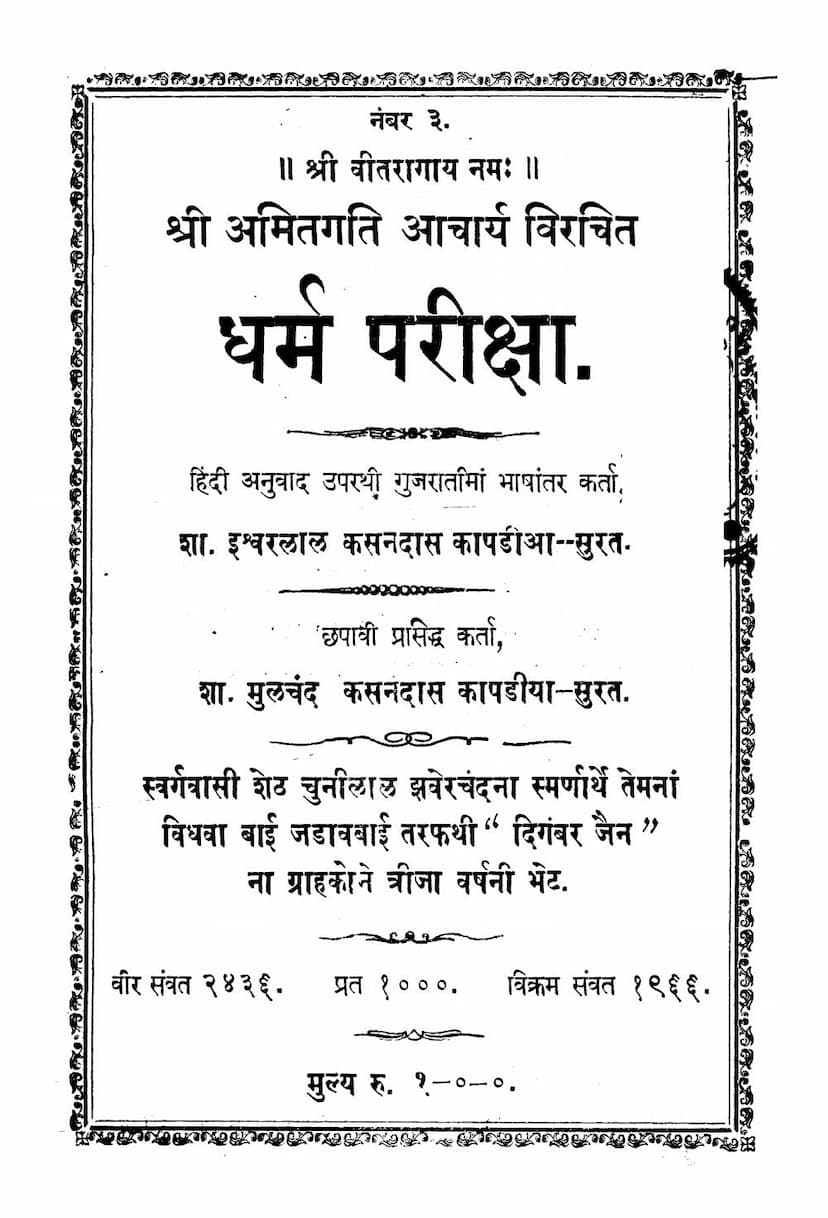Dharmpariksha
Added to library: September 1, 2025

Summary
Here's a comprehensive summary of the Jain text "Dharmpariksha" by Ishwarlal Karsandas Kapadia, based on the provided catalog link and the Gujarati text:
Title: Dharmpariksha (A Test of Dharma) Author: Shri Amitgati Acharya (original Sanskrit text) Translator (Gujarati): Shravak Ishwarlal Karsandas Kapadia (Surat) Publisher: Shravak Mulchand Karsandas Kapadia (Surat) Context: The book is presented as a gift from Smt. Jadavbai, widow of the late Sheth Chunilal Jhaverchand, to the subscribers of the "Digambar Jain" magazine in the year Vir Samvat 2436 (Vikram Samvat 1966).
Overview:
"Dharmpariksha" is a significant Jain text authored by the renowned Jain scholar Shri Amitgati Acharya in the 11th century. The book's primary purpose is to critically examine and differentiate the true principles of Jainism from those of other contemporary religions and philosophical systems. It aims to highlight the superiority and truthfulness of Jain doctrines while exposing the flaws and inconsistencies in opposing viewpoints.
Key Themes and Content:
The book is structured into a series of chapters (Prakaranas) that delve into various aspects of religious philosophy, ethics, and comparative religion. Here's a breakdown of the core themes and content as presented in the translated Gujarati text:
-
The Need for Dharmpariksha: The preface emphasizes the importance of such a text, especially in Gujarat, where there was a perceived lack of accessible religious literature that could illuminate the essence of Jainism and the perceived shortcomings of other faiths. The translation into Gujarati was undertaken to make this profound knowledge available to the Gujarati-speaking community.
-
Comparative Religious Discourse: The central theme of "Dharmpariksha" is the examination and refutation of non-Jain beliefs and practices. Acharya Amitgati uses a dialectical approach, often presenting the arguments of opposing philosophies and then systematically dismantling them with logic, scriptural evidence (from Jain perspective), and ethical reasoning.
-
Exposing Hypocrisy and Superstition: The text strongly criticizes practices that are considered superstitious, hypocritical, or lacking in true spiritual merit in other religions. This includes rituals not aligned with non-violence, flawed cosmologies, and misinterpretations of divine beings.
-
The Story of Manoveg and Pavanveg: A significant portion of the book involves a narrative framework where Manoveg, a learned Jain disciple, engages in debates and discussions with followers of other religions, most notably Pavanveg, who represents a non-Jain perspective. Through these dialogues, Manoveg elucidates the principles of Jainism, such as ahimsa (non-violence), aparigraha (non-possession), anekantavada (non-absolutism), and the concept of karma.
-
Critique of Other Deities and Philosophies: The book critiques the perceived anthropomorphism and limitations of deities in other religions, contrasting them with the Jain ideal of the Arhat (Tirthankaras) who are free from passions and imperfections. It also addresses philosophical concepts like the creation of the universe, the nature of the soul, and the path to liberation, arguing for the Jain perspective on these matters.
-
Ethical Teachings and Practical Guidance: Beyond philosophical debates, "Dharmpariksha" offers profound ethical guidance for both ascetics and householders. It elaborates on the vows of Jainism, the importance of right conduct, the detrimental effects of worldly desires, and the ultimate goal of moksha (liberation).
-
Illustrative Narratives and Analogies: Acharya Amitgati masterfully employs stories, analogies, parables, and ethical maxims to make complex philosophical points accessible and memorable. The Gujarati translation highlights the engaging nature of these narratives.
-
The Author's Intent and Humility: The translator's preface expresses gratitude to the patrons and acknowledges that despite careful efforts, some errors might remain, humbly requesting readers to point them out for future improvement. The translator also provides a brief biography of Sheth Chunilal Jhaverchand, whose memory the book honors, highlighting his contributions to the Jain community and his religious devotion.
-
Specific Chapters (as indicated by the titles): The summary provides descriptions for multiple chapters, covering topics such as:
- Mishap and the Serpent's Riddle (Chapter 2): A traveler's perilous journey through a forest, encountering a serpent, illustrating the dangers of the cycle of birth and death.
- The Illusion of Happiness: The text discusses the ephemeral nature of worldly pleasures and the profound suffering inherent in the cycle of existence.
- The Nature of Dharma and Adharma: The book emphasizes that true dharma is characterized by compassion, non-violence, and truthfulness, while adharma leads to suffering.
- The Flaws in Other Philosophies: Various chapters meticulously dissect and criticize the philosophies of different schools, exposing their internal contradictions and deviation from true spiritual principles.
- The Importance of Right Faith and Conduct: The text consistently advocates for adherence to Jain principles, including right faith (Samyakdarshan), right knowledge (Samyakgyan), and right conduct (Samyakcharitra).
- Critique of Rituals and Deities: The book questions the efficacy of rituals performed without genuine understanding or the worship of deities who themselves are subject to the cycle of birth and death.
- The Concept of Karma: The underlying Jain principle of karma, where actions have consequences, is implicitly or explicitly woven into the discussions.
- The Superiority of Jainism: The overarching message is the unique path to liberation offered by Jainism, free from the flaws and limitations found in other systems.
Significance:
"Dharmpariksha" serves as a cornerstone text in Jain apologetics and comparative religious studies. It provides a reasoned defense of Jain philosophy and offers a critical perspective on the beliefs and practices of other traditions from a Jain viewpoint. The Gujarati translation made this rich intellectual heritage accessible to a wider audience, fostering a deeper understanding of Jain principles.